Impact of ThryvOn® Technology on Key Thrips and Lygus Pest Populations in the Midsouth
February 24, 2025
TRIAL OBJECTIVE
- ThryvOn® Technology provides cotton growers with a novel pest management tool for use against key thrips species and lygus bugs.*
- This trial endeavored to answer questions associated with the use of this technology, particularly about insect treatment thresholds and the response of the technologies against the endemic insect pests present at the Bayer Crop Science Learning Center at Scott, MS during 2024.
- These questions include:
- What effect will ThryvOn® Technology have on key thrips populations in cotton fields?
- How much impact will ThryvOn® Technology have on potential lygus pest populations?
*Scouting is critical to determine which and how many insecticide applications are recommended to avoid economic loss greater than pest management costs (i.e., when economic thresholds are met). Check with your local university extension for the latest spraying recommendations.
RESEARCH SITE DETAILS

- Intrepid Edge® insecticide was applied at 4 fl oz/acre for all thrips treatments.
- Transform® WG insecticide was applied at 2 oz/acre as need according to threshold.
- All field work, tillage, and herbicides were per local standards. Products planted for this study included:
- Deltapine® brand cotton varieties
- DP 2414 B3TXF
- DP 2115 B3XF
- DP 2328 B3TXF
- DP 2333 B3XF
- Technology:
- Bollgard® 3 XtendFlex® Technology
- Bollgard® 3 ThryvOn® cotton with XtendFlex® Technology
- Deltapine® brand cotton varieties
- All plots were scouted weekly on an individual basis for both thrips and lygus bugs.
- Thrips were sampled via plant collection into soapy water, washing over fine mesh screens and counting under a microscope. This allowed classification and documentation of adult and larval thrips populations.
- Thrips damage was visually monitored during the early season.
- Lygus were scouted weekly by either sweep net or drop cloth as dictated by plant status.
- Both thrips and lygus were treated individually with appropriate insecticides according to state threshold recommendations. Plots were planted as 12-row plots, 0.24 acre per plot, as single-replication strip plots.
- The center 6 rows were harvested for yield estimations, 0.12 acre per plot harvested.
- Data were collected as follows:
- Weekly scouting for both lygus and thrips as appropriate.
- Two thrips samples were taken: on 5/28/2024 and 6/5/2024 and averaged across both dates.
- Lygus sampled weekly as appropriate – data not shown.
- Machine harvested yield.
UNDERSTANDING THE RESULTS
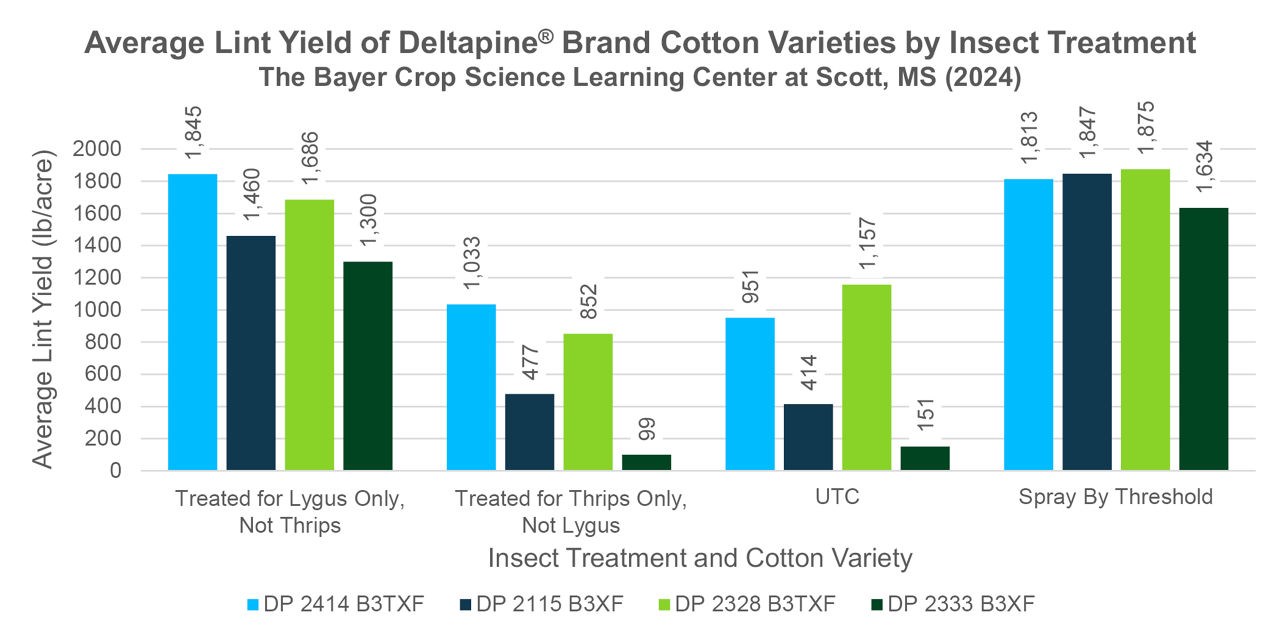
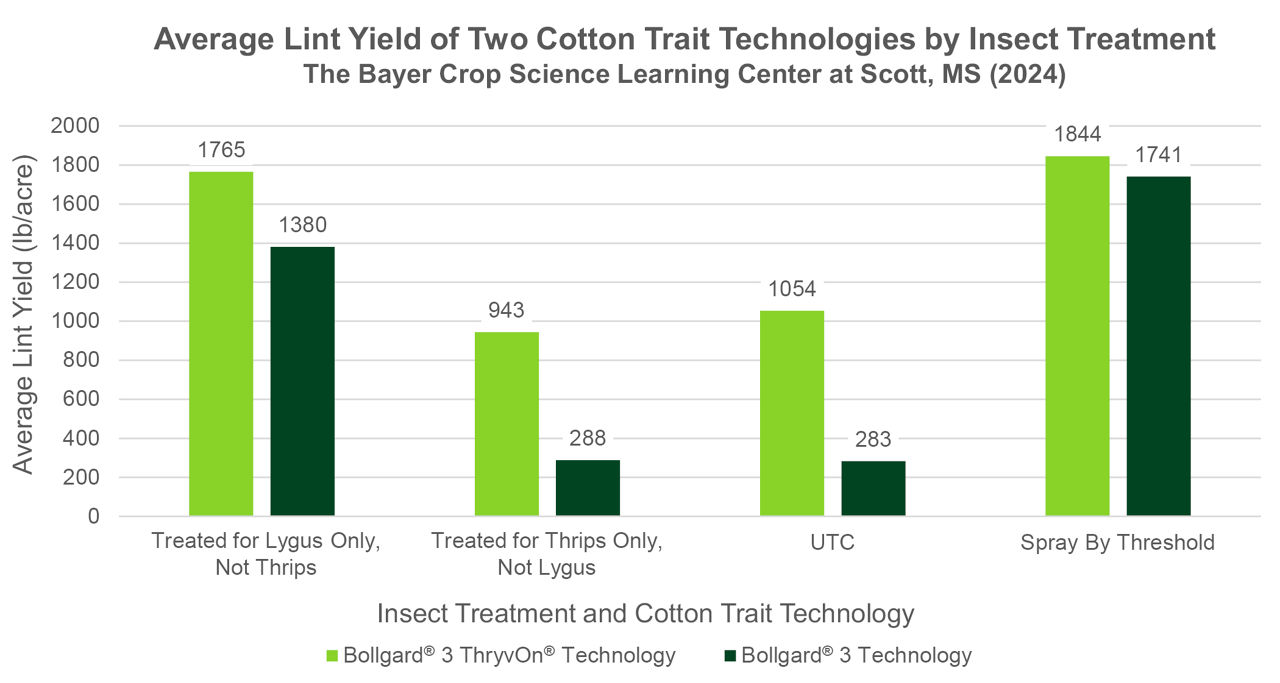
Yield Analysis by Treatments Tested:
- Treated for Lygus Only, Not Thrips
- Bollgard® 3 ThryvOn® Technology: 1,765 lbs lint/acre
- Bollgard® 3 Technology: 1,380 lbs lint/acre
- There was a 21.8% yield reduction from thrips damage in the products without ThryvOn® Technology, compared to those with ThryvOn® Technology.
- Treated for Thrips Only, Not Lygus
- Bollgard® 3 ThryvOn® Technology: 943 lb lint/acre
- Bollgard® 3 Technology: 288 lb lint/acre
- There was a 69.5% yield reduction from lygus damage in the products without ThryvOn® Technology, compared to those with ThryvOn® Technology.
- UTC, Untreated Control
- Bollgard® 3 ThryvOn® Technology: 1,054 lb lint/acre compared to 1,844 lb/acre for the Spray by Threshold treatment (a 42.8% reduction for the UTC).
- Bollgard® 3 Technology: 283 lb lint/acre compared to 1,741 lb lint/acre for the Spray by Threshold treatment (an 83.7% reduction for the UTC).
- The was a 73.2% reduction in yield from the combination of thrips and lygus damage for the varieties with Bollgard® 3 Technology compared to those with Bollgard® 3 ThryvOn® Technology.
- Spray By Threshold
- Bollgard® 3 ThryvOn® Technology: 1,844 lb lint/acre
- Bollgard® 3 Technology: 1,741 lb lint/acre
- There was a 5.6% reduction in yield from varieties with Bollgard® 3 Technology compared to those with Bollgard® 3 ThryvOn® Technology.
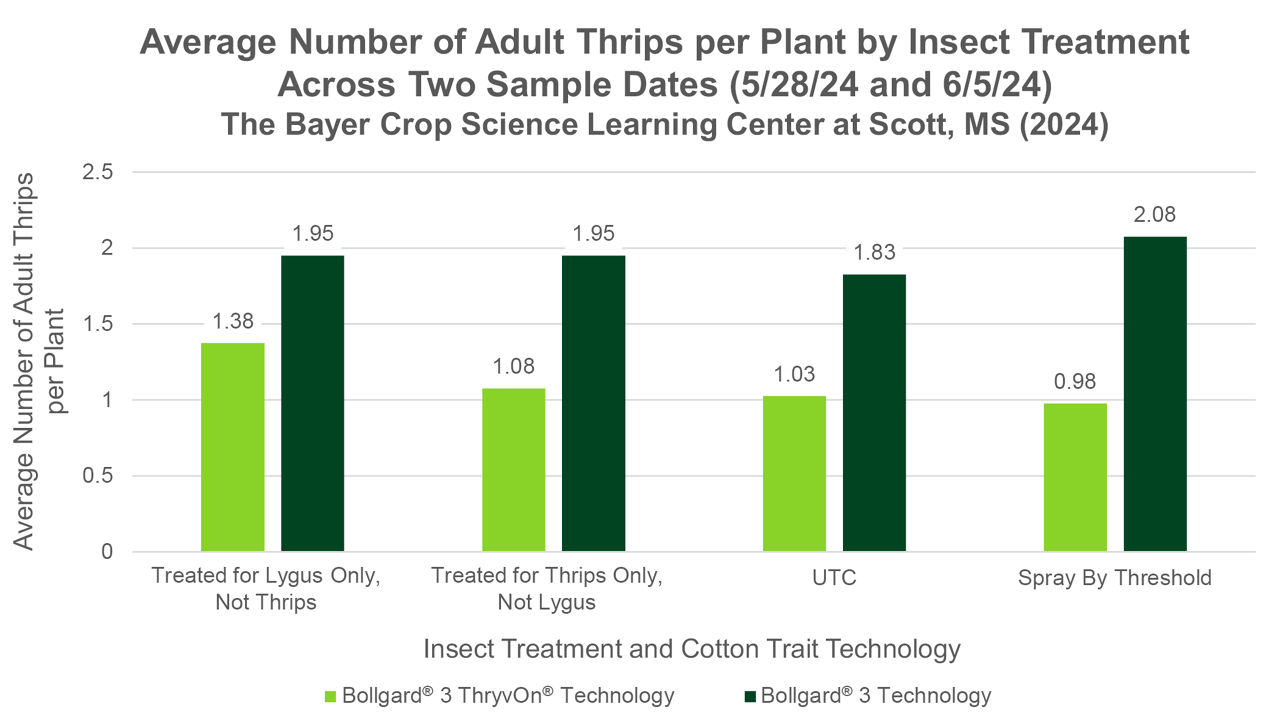
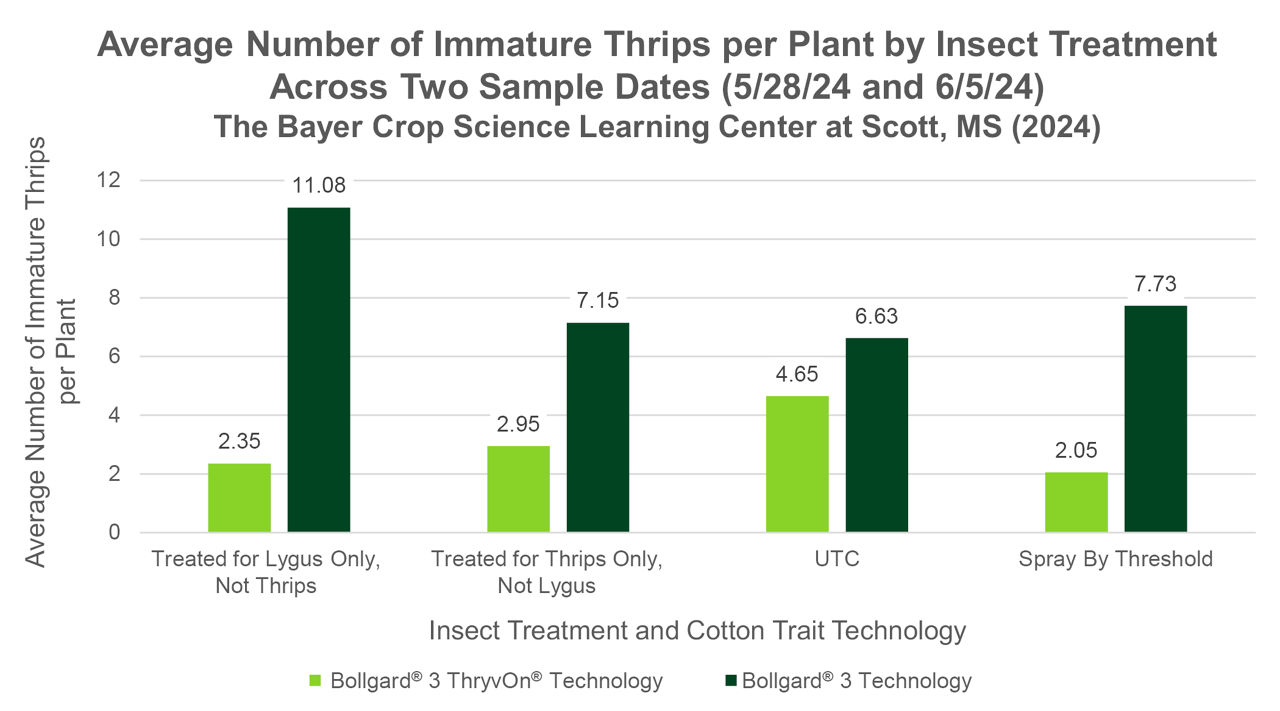
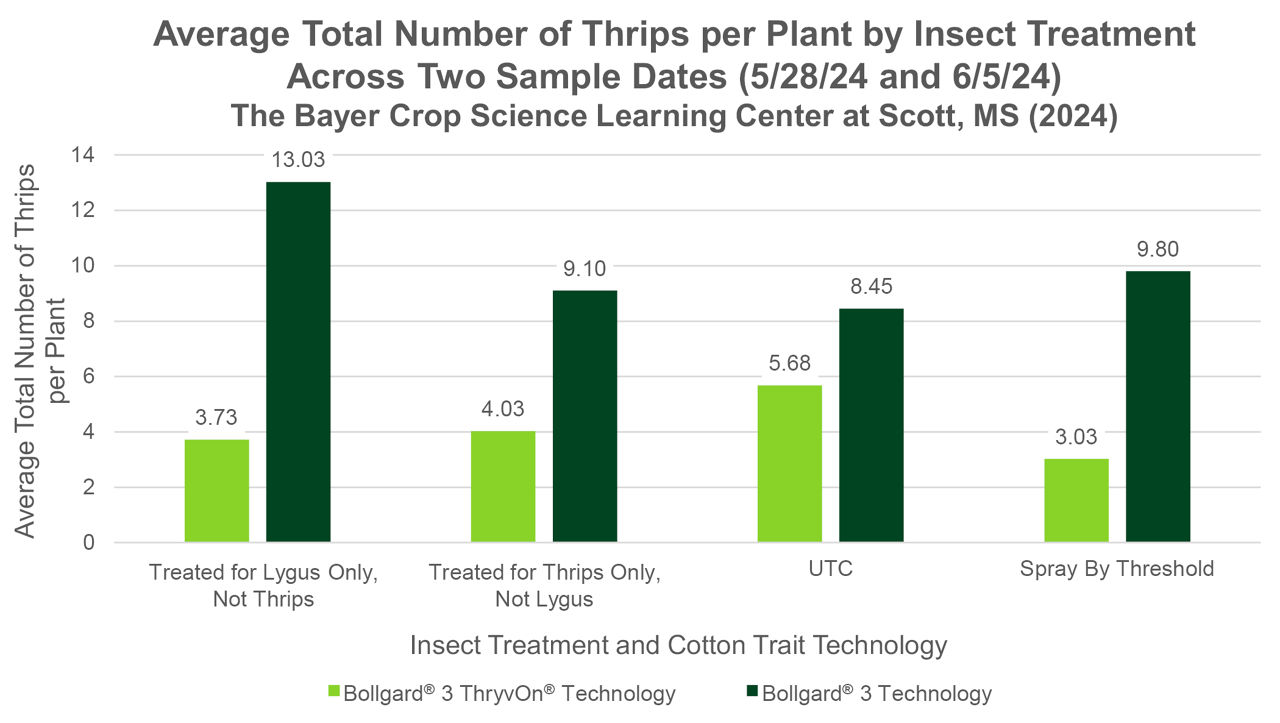
- General Conclusions:
- Fewer thrips were collected from Bollgard® 3 ThryvOn® Technology plots across the study, regardless of threshold treatment applied.
- Thrips inflicted little to no yield damage in the Bollgard® 3 ThryvOn® Technology plots which were untreated for thrips.
- Varieties with only Bollgard® 3 Technology had substantial thrips damage. This damage can be described as both mechanical damage from feeding and delayed maturity associated with recovery from the mechanical damage. This is difficult to measure but was easily observable in the plots.
- In the thrips-treated, Bollgard® 3 Technology-only plots, thrips feeding and reproduction continued substantially as measured by scouting, even with insecticide applications applied for pest control.
- Lygus had a large influence on yield performance across the study. When left untreated, both technologies tested had yield reductions as a result of the lygus populations present in the study. The Bollgard® 3 Technology plots suffered much greater damage (as a percentage) compared to the Bollgard® 3 ThryvOn® Technology plots.
- When sprayed by threshold, both technologies appeared to express optimal yield potential, with the Bollgard® 3 ThryvOn® Technology varieties showing a 5.9% increase compared to the Bollgard® 3 Technology only varieties.
KEY LEARNINGS
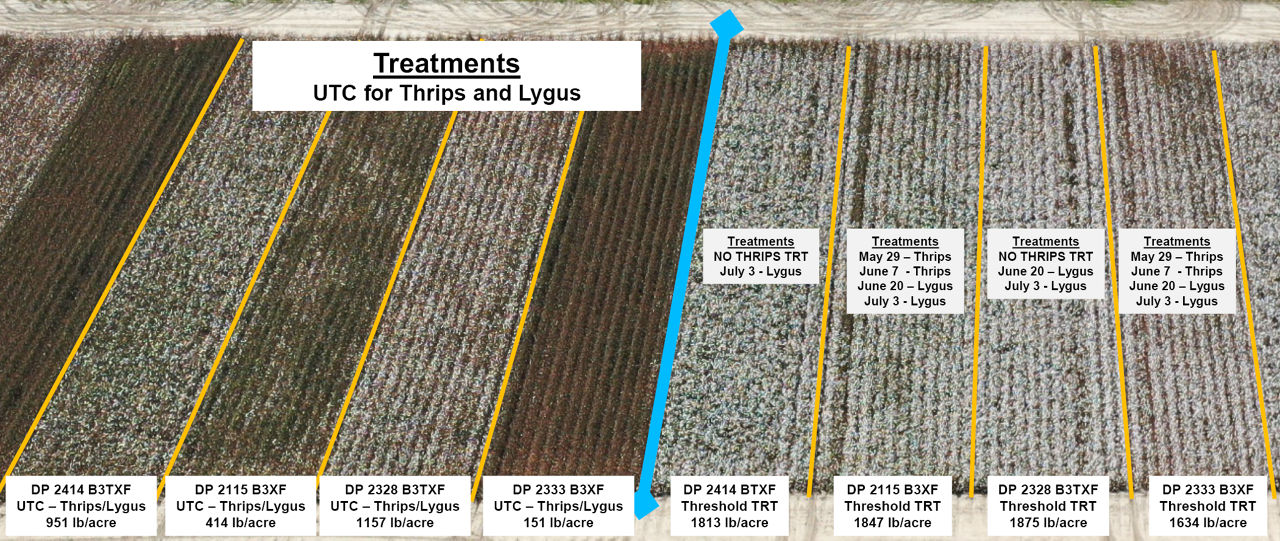
- The data from this trial indicated that the trait technology and insect treatment both effected the yield results, and that there was an interaction between insect treatment and trait technology.
- Placement, management, and agronomic inputs remain very important to optimizing the potential of all cotton products regardless of trait technology.
- ThryvOn® Technology offers a powerful thrips management tool with no treatments required for thrips across this trial. Thrips were and will likely be present at numbers in excess of historical thresholds, but they have not inflicted corresponding levels of damage in varieties with ThryvOn® Technology at the Bayer Learning Center at Scott, MS.
- Even though varieties with ThryvOn® Technology demonstrated resistance to lygus damage, treatments for lygus were still required in both technologies across the study as dictated by threshold. DP 2414 B3TXF only required one application, compared to two in DP 2328 B3TXF and the varieties with Bollgard® 3 Technology only. This is consistent with broad field experience and may be a result of an interaction with varietal maturity or determinance.
- Large populations of migrating adult lygus bugs (and potentially immatures at high levels) will always require treatment. An effect of ThryvOn® Technology on lygus populations may be observed later in the season.
- When lygus populations exceed the recommended state thresholds, make applications of recommended materials as required.
- Please contact your local Deltapine® brand representative for more information.
1415_496792